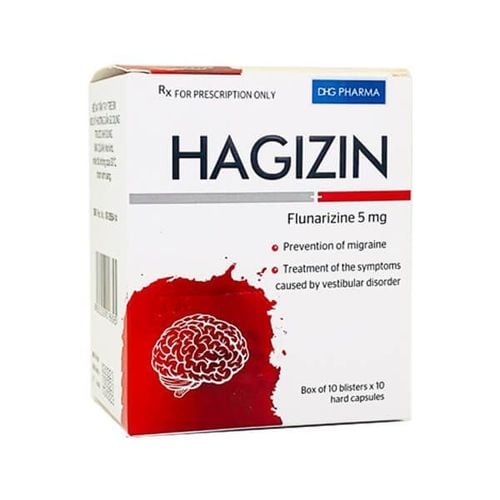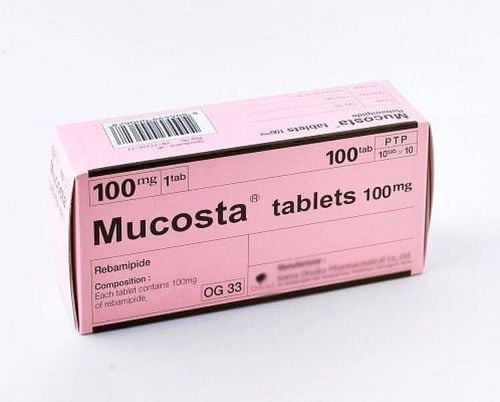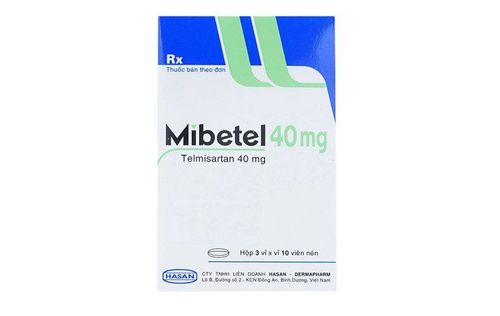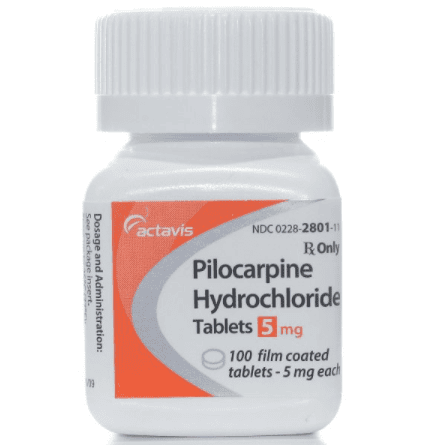This is an automatically translated article.
Cevimeline is used to treat symptoms of dry mouth caused by certain immune diseases (Sjogren's syndrome). So how to use Cevimeline? Let's find out the necessary information about Cevimeline through the article below.
1. What is Cevimeline?
Drug name: Cevimeline
Drug type: Cholinergic agonist; binds to muscarinic receptors.
Drug form and strength: 30 mg oral capsule.
2. Uses of Cevimeline
What does Cevimeline do? Cevimeline is indicated for the symptomatic treatment of dry mouth (Xerostomia) in patients with Sjogren's syndrome. Cevimeline belongs to a class of drugs known as cholinergic stimulants. This medication works by stimulating certain nerves to increase saliva production, making it easier and more comfortable to speak and swallow.3. Dosage and how to use Cevimeline
Dosage:
Take the drug with or without food
Dosage:
Adults:
Treatment of dry mouth (xerostomia) associated with Sjogren's syndrome: Take 30 mg 3 times a day.
The safety and efficacy of doses >90 mg daily have not been established.
Other subjects:
Elderly people: Same as adult dose.
4. Overdose - Missing dose of Cevimeline and handling
Overdose and treatment
Symptoms:
Overdose symptoms may include: headache, vision problems, confusion, sweating, tremors, vomiting, diarrhea, feeling short of breath and irregular heartbeat.
Management:
Management of signs and symptoms of acute overdose is similar to that for poisoning with other Muscarinic agonists: General supportive measures should be taken. If indicated, atropine, an anticholinergic, can be given as an emergency use antidote for patients who have overdosed on Cevimeline. Epinephrine may also be of value in patients with severe cardiovascular depression or bronchospasm. Missed dose and treatment:
If you forget to take a dose, take it as soon as you remember. However, if it is almost time for your next dose, skip the missed dose and take your next dose at the scheduled time. Do not take twice the prescribed dose.
5. Side effects of the drug Cevimeline
Common:
Sweating, nausea, sinusitis, rhinitis, upper respiratory tract infection, chest pain, edema, palpitations, peripheral edema, fatigue, insomnia, depression, hypertonia muscle, numbness, decreased tendon reflexes, migraine, dizziness, dermatosis, red rash, pruritus, hot flushes, increased amylase, abdominal pain, vomiting, increased salivation, loss of appetite. Aphthous stomatitis, constipation, dyspepsia, flatulence, gastroesophageal reflux disease, hiccups, salivary gland pain, salivary gland inflammation, toothache, dry mouth, urinary tract infection, cystitis, vaginitis, anemia, hypersensitivity reactions, abscesses, candidiasis, fungal infections, infections, back pain, joint pain, bone pain, asthenia . Leg cramps, muscle pain, tremor, eye disease, eye infection, eye pain, visual disturbance, dry eye, earache, otitis media, cough, bronchitis, nosebleed, similar symptoms flu, pneumonia, accidental injury, fever. Uncommon and rare:
Exacerbation of multiple sclerosis, aggressive behavior, hair loss, angina pectoris, anterior chamber hemorrhage, aphasia, respiratory arrest, joint disease,.... Bronchospasm.... , blistering, bundle branch block, arrhythmia, cardiovascular disease, cholecystitis, gallstones,.... Diabetes, dyskinesia, ECG abnormalities, fluctuating emotions, leukocytosis eosinophilia, esophageal stricture, esophagitis, extrasystoles, facial edema, peptic ulcer,... Hematoma, hematuria, liver failure, hyperglycemia, hyperkalemia, hypertension, hypoglycemia , hypotension, hypothyroidism, immune thrombocytopenia, impotence, elevated liver enzymes. Kidney stones, neuropathy, paralysis, paraesthesia, paresthesia, peptic ulcer, pericarditis, peripheral ischemia, allergic photoallergic reactions on the skin. Tachycardia, tenosynovitis, thrombocytopenia, thrombophlebitis, ulcerative colitis, urinary retention, urinary disturbances, vasculitis.
6. Precautions when using Cevimeline
Contraindications
Cevimeline is contraindicated in the following cases:
Patients with hypersensitivity to Cevimeline. Uncontrolled asthma. Patients with undesirable pupillary constriction (acute iritis, angle-closure glaucoma). General Note
Cevimeline has a risk of causing disturbances in cardiac conduction and (or) heart rhythm. Patients with clinically significant cardiovascular disease may not be able to tolerate transient changes in hemodynamics or heart rate caused by Cevimeline. Use with caution and under close medical supervision in patients with a history of cardiovascular disease (eg, angina, myocardial infarction). Cevimeline has the potential to increase bronchial smooth muscle tone, bronchial secretions, and airway resistance. Use with caution and under close medical supervision in patients with asthma, chronic bronchitis, or COPD. Blurry vision has been reported in association with ophthalmic forms of muscarinic agonists. Cevimeline may cause impaired depth perception and reduced visual acuity, especially at night and in patients with preexisting vitreous changes. Cevimeline may also decrease your ability to drive at night or to perform hazardous activities in reduced light. Cevimeline may potentiate parasympathetic effects (eg, headache, visual disturbances, lacrimation, sweating, respiratory disturbances, gastrointestinal spasms, nausea, vomiting, diarrhea, atrioventricular block, tachycardia, bradycardia, hypotension, hypertension, shock, altered consciousness, arrhythmia, tremor). Sweating is the most common side effect. Excessive sweating can cause the body to lose water. Cevimeline may cause spasm of the gallbladder or biliary smooth muscle and may lead to complications (eg, cholecystitis, cholangitis, biliary obstruction) in patients with gallstones. Use with caution in patients with a history of gallstones. Cevimeline increases ureteral smooth muscle tone which could theoretically lead to renal colic or ureteral reflux in patients with kidney stones. Use with caution in patients with a history of kidney stones. Patients with suspected or known deficiency of CYP2D6 enzyme activity may be at increased risk for the effects of reduced metabolism of Cevimeline in these patients. Note to pregnant women:
There is insufficient information on the safety of the drug in controlled studies in pregnant women; a reduction in the number of embryos that implanted has been observed in animal studies. Use during pregnancy only if the potential benefits and risks to the fetus have been weighed. Note to nursing women:
There are no data to show whether Cevimeline is distributed into breast milk, the drug should be discontinued or breast-feeding should be discontinued in this case
Precautions when driving or operating machinery:
Blurred vision reported in association with ophthalmic forms of Muscarinic agonists. The drug may cause impaired visual depth perception and reduced visual acuity, especially at night and in patients with preexisting vitreous changes; The drug may also reduce the ability to drive at night or to perform hazardous activities in reduced light conditions.
7. Drug interactions
Interactions with other drugs:
With Acetylcholinesterase inhibitors: Cevimeline may increase the side effects, harmful effects of cholinergic agonists, cholinergic effects may be enhanced. With beta-blockers: Cevimeline may increase the side effects, harmful effects of Cevimeline. Among these, the possibility of cardiac conduction abnormalities and bronchospasm should be considered. With Cimetropium: Cevimeline may reduce the anticholinergic effects of cimetropium. Cevimeline's influence on gallbladder function may reduce the therapeutic effect of Sincalide. Consider discontinuing medications that may affect gallbladder motility before using Sincalide to stimulate gallbladder contractions. Food interactions:
Food slows down absorption; When administered after a meal, peak Cevimeline concentrations decreased by about 17%. Drug interactions can change how a drug works or increase the effect of side effects. The article has provided information on what Cevimeline is used for, dosage and precautions for use. To ensure safety for your health and maximize the effectiveness of your treatment, you need to take Cevimeline exactly as directed by your doctor. Store Cevimeline in a dry place, the temperature does not exceed 30 degrees Celsius and out of the reach of small children.
Please dial HOTLINE for more information or register for an appointment HERE. Download MyVinmec app to make appointments faster and to manage your bookings easily.













